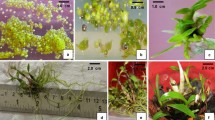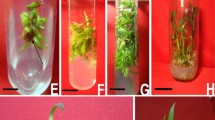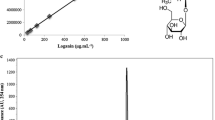Abstract
Genetic and metabolomic demarcations between two Indian and one American congeners of Genus Panax have been discerned. Genomic DNA was isolated from the root derived callus cultures of these species and amplified by AP-PCR. RAPD analyses of the DNA with six most responding arbitrary oligonucleotide decamers provided a total of 70 reproducible bands for computation of the similarity matrix amongst the Panax species. Only 18 of these were monomorphic giving an estimate of about 74% polymorphism among the test species examined. The similarity coefficient values based on the amplification pattern support an equidistant position of the three test species. The molecular demarcations between the species are also manifested in terms of their characteristic cultural requirements, in vitro growth kinetics, regeneration competence and ginsenoside complement of their calli. The Indian congeners i.e. P. sikkimensis and P. pseudoginseng were distinguishable by higher proportions of ginsenoside Rf and Ro (40% and 20%, respectively) in the crude saponin fractions. Furthermore P. quinquefolium calli mainly accumulated ginsenoside Rb2 and Rg1, whilst P. sikkimensis callus was rich in Rd fraction. P. quinquefolium showed high similarity with P. sikkimensis with respect to plasticity and totipotency for somatic embryogeny whereas P. pseudoginseng callus was highly recalcitrant and lacked regenerative capacity. The chemical and genetic fingerprints alongwith morphogenetic responses of the three species under controlled in vitro environment strongly advance the case of P. sikkimensis as an independent species, rather than a conglomerate of location specific variety or sub-species of P. pseudoginseng. The findings are also of relevance to formulations and evaluation of ginseng-based health foods.
Similar content being viewed by others
References
Awang D.V.C. 2000. The neglected ginsenosides of North American ginseng (Panax quinquefolium L.). J. Herbs Species Med. Pl. 7: 103–109.
Bai D., Brandle J. and Reeleder R. 1997. Genetic diversity in North American ginseng (Panax quinquefolius L.) grown in Ontario detected by RAPD analysis. Genome 40: 111–115.
Banerjee R.N. 1968. A taxonomic revision of Indian Panax Linn. (Araliaceae). Bull. Bot. Surv. India 10: 20–27.
Bennet S.S.R. and Sharma B.K. 1983. Indian ginseng. Indian Forester 109: 840–847.
Boehm C.L., Harrison H.C., Jung G. and Nienhuis J. 1999. Organiwere zation of American and Asian ginseng germplasm using randomly amplified polymorphic DNA (RAPD) markers. J. Amer. Soc. Hort. Sci. 124: 252–256.
Cannon J.F.M. 1979. An Enumeration of Flowering Plants of Nepal 2. British Museum, London, p. 192.
Cheung K., Kwan H., But P. and Shaw O. 1994. Pharmacological identification of American and Oriental ginseng roots by genomic fingerprinting using arbitrarily primed polymerase chain reaction (AP-PCR). J. Ethanopharmacol. 42: 67–69.
Choi K.T. 1988. C. A. Meyer: Micropropagation and the in vitro production of saponins. In: Bajaj Y.P.S. (ed.), Biotechnology in Agriculture and Forestry. Medicinal and Aromatic Plants I Vol. 4. Springer Verlag, Berlin, pp. 484–500.
Dou D.Q., Hou W.B. and Chen Y.J. 1998. Studies on characteristic constituents of Chinese ginseng and American ginseng. Pl. Med. 64: 585–586.
Goodwin P.H. and Annis S.L. 1991. Rapid identification of genetic variation and pathotype of Leptosphaeria maculans by random amplified polymorphic DNA assay. Appl. Environ. Microbiol. 57: 2482–2486.
Haster C. 1998. A new look at an ancient concept. Chem. Ind. (Feb. 2) 84–89.
Haughton P. 1999. Roots of remedies: plants, people and pharmaceuticals. Chem. Ind. (Jan. 4) 15–19.
Hu S.Y. 1976. The genus Panax (ginseng) in Chinese medicine. Econ. Bot. 30: 11–28.
Lui J.H. and Staba E.J. 1980. The giusenosides of various ginseng plants and selected products. J. Nat. Prod. 43: 340–346.
Ma Y.C., Zhu J., Benkrima L., Luo M., Sun L., Sain S. et al. 1995. Comparative evaluation of ginsenosides in commercial ginseng products and tissue samples using HPLC. J. Herbs, Species & Med. Pl. 3: 41–50.
Mathur A., Mathur A.K., Pal M. and Uniyal G.C. 1999. Comparison of qualitative and quantitative in vitroginsenoside production in callus cultures of three Panax species. Pl. Med. 65: 484–486.
Mathur A., Mathur A.K. and Gangwar A. 2000. Saponin production by cell / callus culture of Panax species. In: Oleszek W. and Marston A. (eds), Saponins in Food, Feedstuffs and Medicinal Plants. Kluwer Academic Publishers, Netherlands, pp. 171–179.
Mathur A., Mathur A.K. and Gangwar A. 2001. In vitro plantlet regeneration in Panax sikkimensis. Pl. Med. 67: 181–183.
Mathur A., Shukla Y.N., Pal M., Ahuja P.S. and Uniyal G.C. 1994. Panax quiquefolium. Phytochemistry 35: 221–1225.
Metha J.K. and Haridasan K. 1992. The ginsengs in Arunachal Pradesh. Arunachal Forest-News 10: 56–58.
Ngan F., Shaw P., But P. and Wang J. 1999. Molecular authentication of Panax species. Phytochemistry 50: 787–791.
Nocerino E., Amato M. and Izzo A.A. 2000. The aphrodisiac and adaptogenic properties of ginseng. Fitoterapia 71: 51–55.
Proctor J.T.A. and Bailey W.G. 1987. Ginseng: Industry, Botany and Culture. Hortic. Rev. 9: 187–236.
Pang J.P. Chen L.F.O. and Chen S.-C.G 1992. DNA polymorphism generated by arbitrarily primed PCR in rice. Bioscience, Biotechnol. Biochem. 56: 1357–1358.
Sangwan R.S., Kumar S. and Sangwan N.S. 1998. Isolation of Geomic DNA from anti malarial plant Artemisia annua. L. Plant Mol. Biol. Rep. 16: 365.
Sangwan R.S., Sangwan N.S., Jain D.C., Kumar S. and Renade S.A. 1999. RAPD profile based genetic characterization of chemotypic variants of Artemisia Annua L. Biochem. Miol Biol. Intl. 47: 935–944.
Sangwan N.S., Yadav U. and Sangwan R.S. 2001. Molecular analysis of genetic diversity in elite Indian cultivars of essential oil trade types of aromatic grasses (Cymbopogonspecies). Pl. Cell. Rep. (in press).
Shaw P.C. and But P.P.H 1995. Auhentication of Panax species and their adulterants by random-primed polymerase chain raction. Pl. Med. 61: 466–469.
Tanaka O., Kasai R. and Morita T. 1986. Chemistry of ginseng and related plants. recent advances. Abstracts. Chinese Med. 1: 130–152.
Thompson G.A. 1991. Botanical characterisitcs of ginseng. In: Craker L.E. and Simon J.E. (eds), Herbs, Spices & Medicinal Plants Vol. 2. The Haworth Press Inc., U.S.A., pp. 111–136.
Wang X., Proctor J.T.A., Kakuda Y., Krishnaraj S. and Saxena P.K. 1999. Ginsenoside in American ginseng. comparison of in vitro derived and.eld plant tissues. J. Herbs, Species. Med. Pl. 6: 1–10.
Walsh J. and McClelland M. 1990. Fingerprinting genomes using PCR with arbitrary primers. Nucleic Acids Research 18: 7213- 7218.CIMAP Publication No. 2001-28J
Author information
Authors and Affiliations
Corresponding author
Rights and permissions
About this article
Cite this article
Mathur, A., Mathur, A., Sangwan, R. et al. Differential morphogenetic responses, ginsenoside metabolism and RAPD patterns of three Panax species. Genetic Resources and Crop Evolution 50, 245–252 (2003). https://doi.org/10.1023/A:1023534927337
Issue Date:
DOI: https://doi.org/10.1023/A:1023534927337




